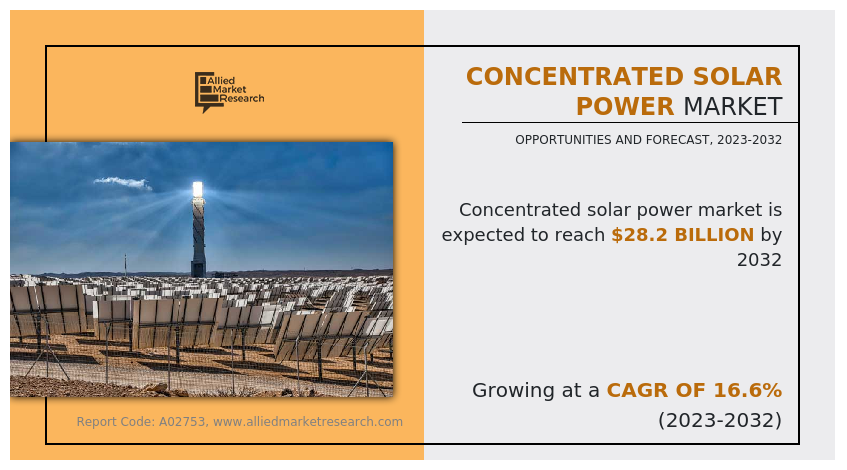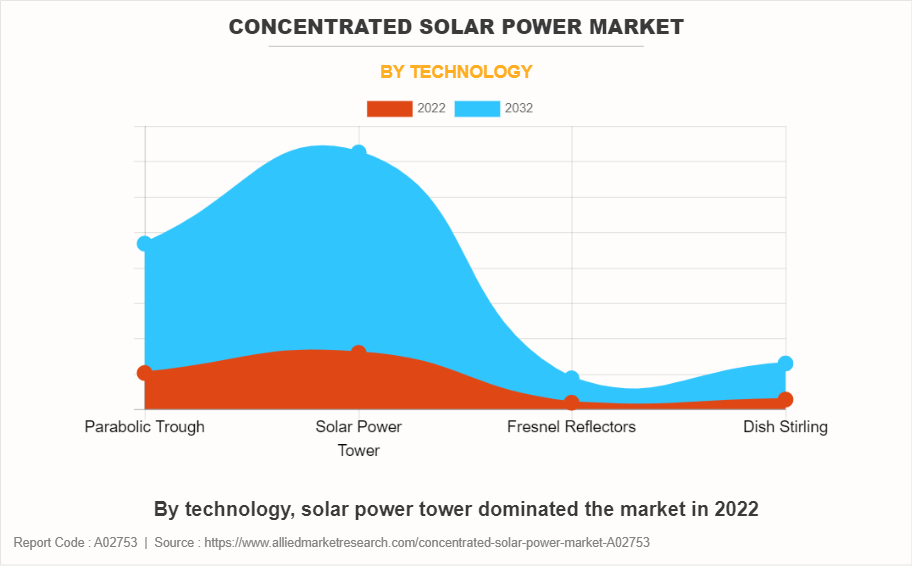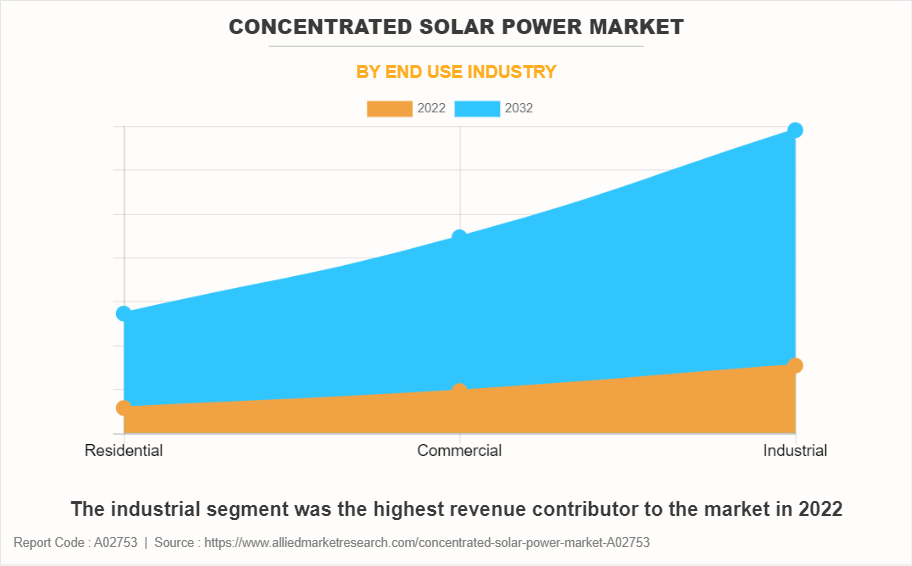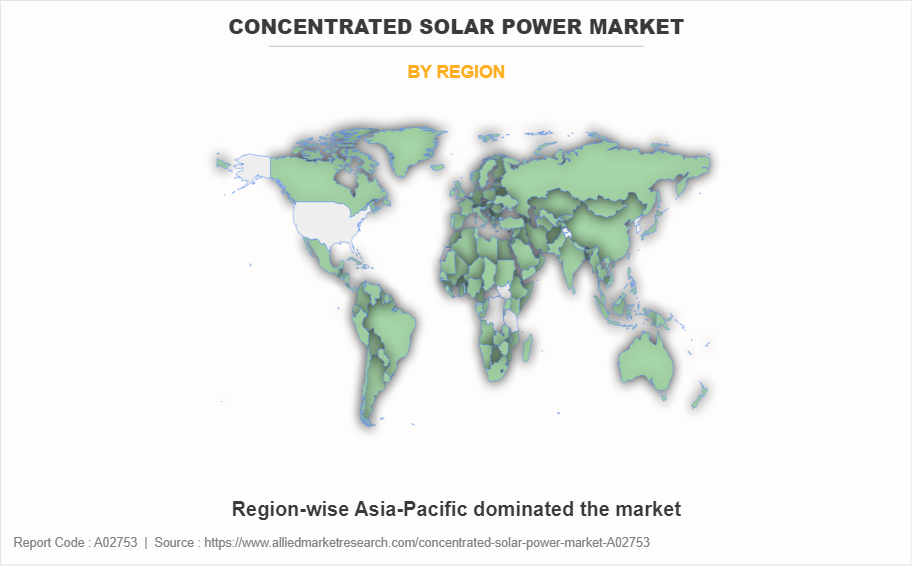Concentrated Solar Power Market Research, 2032
The global concentrated solar power market size was valued at $6.1 billion in 2022, and is projected to reach $28.2 billion by 2032, growing at a CAGR of 16.6% from 2023 to 2032.
Report Key Highlighters:
The global concentrated solar power market share has been analyzed in terms of value ($Million). The analysis in the report is provided on the basis of type, application, 4 major regions, and more than 15 countries.
The global concentrated solar power market report includes a detailed study covering underlying factors influencing the industry opportunities and trends.
The concentrated solar power market is fragmented in nature with few players such as Aalborg CSP, Acciona, ACWA Power, Atlantica Sustainable Infrastructure plc., Brightsource, FRENELL GMBH, General Electric, Rioglass Solar Inc., Sener, and Siemens Energy AG.
The report facilitates strategy planning and industry dynamics to enhance decision making for existing market players and new entrants entering the concentrated solar power industry.
Countries such as China, U.S., India, Germany, and Brazil hold a significant share in the global concentrated solar power market.

Concentrated Solar Power (CSP) refers to a renewable energy technology that harnesses sunlight to generate electricity. CSP systems use mirrors or lenses to concentrate sunlight onto a small area. This concentrated sunlight produces heat, typically used to drive a steam turbine connected to a generator, which then produces electricity. Moreover, there are several types of CSP technologies such as parabolic trough systems, power towers, dish/engine systems, and linear Fresnel reflectors. Each system employs different methods to focus sunlight onto receivers where the heat is collected and transferred to a working fluid, usually a liquid or gas, to generate steam and drive a turbine.
CSP offers the advantage of being a dispatchable form of renewable energy, as some systems store heat for later use, enabling electricity generation even when the sunlight is unable to produce electricity. It is considered an attractive option for utility-scale power generation and has the potential to contribute significantly to the global transition toward cleaner energy sources and reduced greenhouse gas emissions. In addition, CSP is used for various applications such as desalination, industrial process heat, and thermal applications in addition to power generation, offering diverse solutions for energy needs.
CSP technology allows for both large-scale utility plants and smaller, distributed systems. The modular nature of CSP facilitates scalability, enabling the construction of power plants tailored to specific energy needs. In addition, CSP plants integrate thermal energy storage systems, usually using molten salts, allowing for the storage of excess heat generated during the day. This stored energy is used to generate electricity during periods of low or no sunlight, providing a more consistent and reliable power supply compared to some other renewable sources.
Renewable energy enhances security by diversifying portfolios and cutting fossil fuel reliance. Nations such as Sweden, China, and Germany target renewables to meet climate goals that drive CSP, wind, and solar adoption. In addition, R&D boosts CSP efficiency, and advancements in materials and storage make CSP competitive. In addition, CSP technologies use dry cooling systems, significantly reducing water usage compared to conventional thermal power plants. This aspect is crucial in water-stressed regions where water conservation is a priority. All these factors positioned concentrated solar power as a crucial technology in meeting sustainable energy targets and increasing the demand during the forecast period.
However, CSP systems that include intricate technologies such as parabolic troughs or power towers, incur high initial costs due to complex construction, involving mirrors, receivers, and thermal storage. Moreover, the technological complexity of CSP systems extends beyond their physical footprint. Thermal energy storage systems, a crucial aspect of many CSP projects, contribute to the overall cost. All these factors hamper the growth of the concentrated solar market.
Hybridization and system integration in CSP enhance efficiency, reliability, and energy contributions. CSP with renewables or conventional technologies unlocks numerous benefits, broadening solar thermal energy applications. Integrated systems leverage diverse technologies, boosting efficacy and dependability. Moreover, the integration of CSP with photovoltaic or wind forms a hybrid plant that boosts efficiency and maximizes the output. This integration helps to smooth energy fluctuations and ensures consistent supply. All these factors are anticipated to offer new growth opportunities for the concentrated solar power market during the forecast period.
The concentrated solar power market is segmented on the basis of technology, end-use industry, and region. By technology, the market is classified into parabolic trough, solar power tower, Fresnel reflectors, and dish stirling. By end-use industry, the market is divided into residential, commercial, and industrial. By region, the market is analyzed across North America, Europe, Asia-Pacific, and LAMEA.

By technology, the solar power tower segment accounted for more than half of the global concentrated solar power market revenue in 2022 and is expected to maintain its dominance during the forecast period. Solar power tower offers higher efficiency in energy conversion compared to some other CSP technologies. It has the potential to achieve higher temperatures, enabling more efficient electricity generation through steam turbines. This efficiency factor makes solar power tower attractive for utility-scale power generation. In addition, ongoing research and technological advancements in materials, receiver designs, and heliostat controls have contributed to increased efficiency and reduced costs in solar power tower systems. All these factors increase the demand for the solar power tower during the forecast period.

By end-use industry, the industrial segment accounted for half of the concentrated solar power market revenue in 2022 and is expected to maintain its dominance during the forecast period. Industrial sectors often require uninterrupted power sources. CSP, with its ability to integrate thermal energy storage, provides a reliable and dispatchable source of energy, reducing dependence on intermittent renewables and ensuring a consistent power supply. In addition, stringent environmental regulations and corporate sustainability goals drive industries to transition towards cleaner energy sources. CSP carbon-neutral and environmentally friendly nature aligns with these objectives, making it an attractive option for reducing greenhouse gas emissions and environmental impact.

On the basis of region, Asia-Pacific has the highest market share accounting for more than half of the concentrated solar power market revenue in 2022. Rapid economic growth in countries like India and China has led to increased energy demands. CSP offers a viable solution to meet these escalating energy needs while reducing reliance on fossil fuels and diversifying the energy mix. In addition, various governments across the region have implemented supportive policies, incentives, and targets promoting renewable energy adoption. Initiatives such as feed-in tariffs, renewable energy targets, tax incentives, and favorable regulatory frameworks encourage CSP development.
Key players in the concentrated solar power market include Aalborg CSP, Acciona, ACWA Power, Atlantica Sustainable Infrastructure plc., Brightsource, FRENELL GMBH, General Electric, Rioglass Solar Inc., Sener, and Siemens Energy AG. In addition, the market drivers, restraints, and opportunities are explained in the report.
Apart from these major players, there are other key players in the concentrated solar power market growth. These include Abengoa Solar, SolarReserve, TSK Flagsol Engineering GmbH, Schott AG, Therminol, Cobra Group, Idhelio, Novatec Biosol, and Enel Green Power.
Historical trends of concentrated solar power:
In the late 19th century, the early conceptualization of solar power emerged with the harnessing of solar thermal energy for heating water and generating steam. This period marked the initial experiments and small-scale applications of solar energy for industrial and residential purposes.
During the mid-20th century, advancements in solar technologies particularly in the development of concentrating solar power (CSP) systems, began to gain traction. Improved designs of solar collectors and better heat transfer mechanisms laid the foundation for more efficient CSP systems. However, widespread adoption remained limited due to high costs and competing energy sources.
In the late 20th century, the potential of CSP gained attention as a viable renewable energy source. Technological innovations, such as parabolic troughs and power tower systems, improved efficiency and lower costs. Government incentives and renewable energy policies in some regions spurred pilot projects and initial commercial deployments of CSP plants.
The early 21st century witnessed a significant surge in the development of CSP technology. Increasing concerns about climate change and the quest for cleaner energy sources drove renewed interest in solar power. Advances in storage systems, like molten salt technology, addressed the intermittency of solar power, making CSP more reliable and attractive for grid integration.
By the mid-2010s, the global CSP market experienced substantial growth. Larger-scale CSP plants were deployed in various regions, especially in sun-rich areas, to generate electricity at utility-scale levels. Improved efficiency in solar collectors and thermal storage systems further bolstered the attractiveness of CSP as a sustainable energy solution.
In the late 2010s and early 2020s, the CSP market continued its expansion. The focus on decarbonization and the transition towards renewable energy accelerated the deployment of CSP projects worldwide. Collaborative efforts between governments, industries, and research institutions led to breakthroughs in CSP technologies, enhancing efficiency and reducing costs. Integrated storage solutions and hybrid systems increased the reliability and round-the-clock availability of solar power, further cementing CSP's role in the renewable energy landscape.
Key Benefits For Stakeholders
- This report provides a quantitative analysis of the market segments, current trends, estimations, and dynamics of the concentrated solar power market analysis from 2022 to 2032 to identify the prevailing concentrated solar power market opportunities.
- The market research is offered along with information related to key drivers, restraints, and opportunities.
- Porter's five forces analysis highlights the potency of buyers and suppliers to enable stakeholders make profit-oriented business decisions and strengthen their supplier-buyer network.
- In-depth analysis of the concentrated solar power market forecast, and segmentation assists to determine the prevailing market opportunities.
- Major countries in each region are mapped according to their revenue contribution to the global market.
- Market player positioning facilitates benchmarking and provides a clear understanding of the present position of the market players.
- The report includes the analysis of the regional as well as global concentrated solar power market trends, key players, market segments, application areas, and market growth strategies.
Concentrated Solar Power Market Report Highlights
| Aspects | Details |
| Market Size By 2032 | USD 28.2 billion |
| Growth Rate | CAGR of 16.6% |
| Forecast period | 2022 - 2032 |
| Report Pages | 250 |
| By Technology |
|
| By End Use Industry |
|
| By Region |
|
| Key Market Players | FRENELL GMBH, Acciona, Aalborg CSP, Atlantica Sustainable Infrastructure plc., ACWA Power, Sener, Rioglass Solar Inc., Brightsource, Siemens Energy AG, General Electric |
Analyst Review
According to the opinions of various CXOs of leading companies, the concentrated solar power market is expected to witness significant traction during the forecast period. A surge in demand for renewable energy and favorable government incentives, subsidies, and policies are projected to propel the concentrated solar power market during the forecast period.
CSP technology involves harnessing solar power by using mirrors or lenses to concentrate sunlight onto a small area, generating heat that drives a conventional turbine to produce electricity. This approach has gained considerable traction due to its capacity to provide reliable, renewable energy. Moreover, the integration of CSP with other renewable energy systems bolsters overall energy efficiency, amplifying the attractiveness of CSP solutions on the market.
Furthermore, government policies and international agreements promoting the adoption of renewable energy technologies play a pivotal role in fostering CSP initiatives. These supportive regulations incentivize and mandate the deployment of sustainable energy solutions, thereby catalyzing the expansion of the concentrated solar power market during the forecast period.
Hybridization and system integration are the upcoming trends of the concentrated solar power market in the world.
The surge in demand for renewable energy and favorable government incentives, subsidies, and policies are the leading drivers for the concentrated solar power market.
Asia-Pacific is the fastest-growing region for the concentrated solar power market.
Solar power tower segment is the leading technology in the concentrated solar power market.
The global concentrated solar power market was valued at $6.1 billion in 2022, and is projected to reach $28.2 billion by 2032, registering a CAGR of 16.6% from 2023 to 2032.
Key players in the concentrated solar power market include Aalborg CSP, Acciona, ACWA Power, Atlantica Sustainable Infrastructure plc., Brightsource, FRENELL GMBH, General Electric, Rioglass Solar Inc., Sener, and Siemens Energy AG. In addition, the market drivers, restraints, and opportunities are explained in the report.
Asia-Pacific is the largest regional market for concentrated solar power market.
Loading Table Of Content...
Loading Research Methodology...


